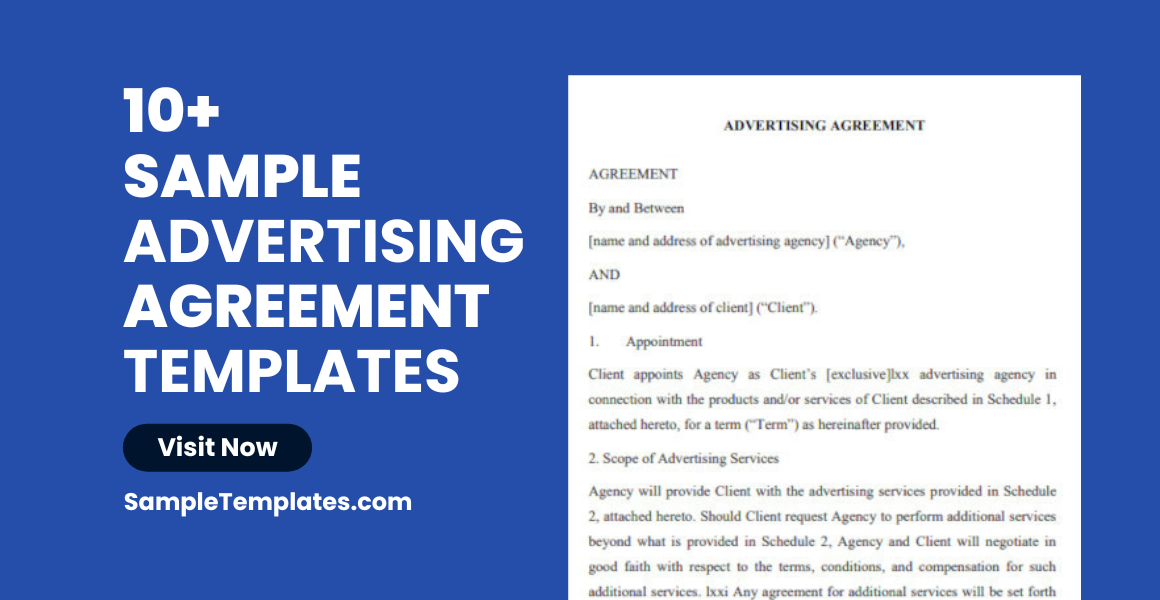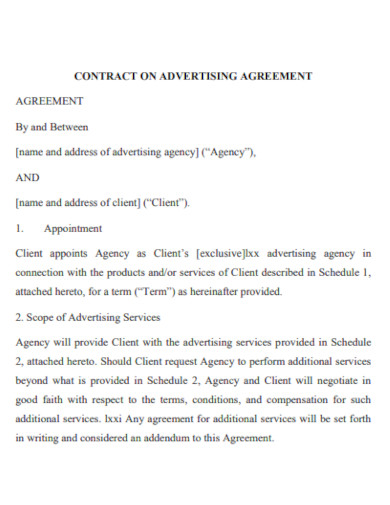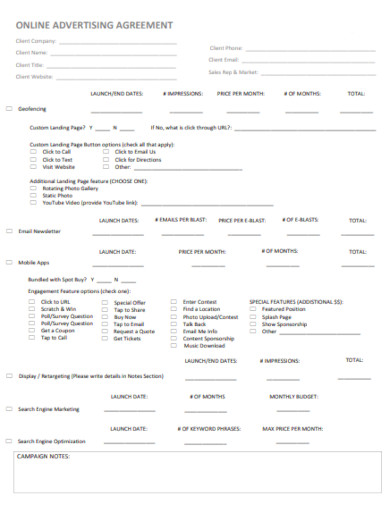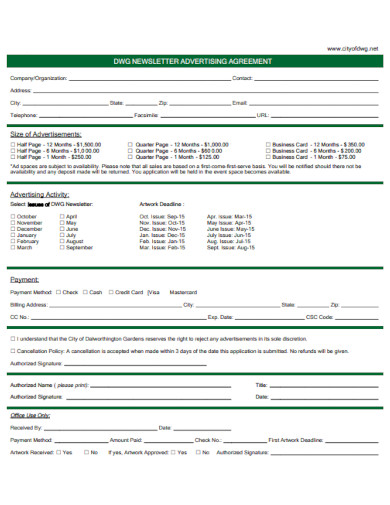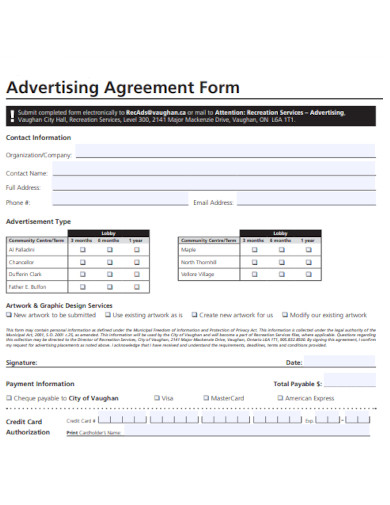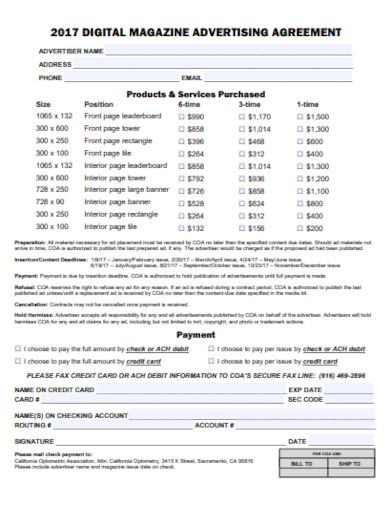An Advertising Agreement encapsulates the specifics of media placement, duration, and content, ensuring that all advertising efforts are in sync with brand values and legal requirements. It outlines the responsibilities of each party, payment schedules, and intellectual property rights, providing a clear roadmap for campaign execution. This contract is not just a formality but a strategic tool that can significantly influence the outcome of marketing campaigns. By setting clear expectations and legal safeguards, it enables businesses to navigate the complex landscape of advertising with confidence and precision.
10+ Advertising Agreement Samples
1. Sample Website Advertising Agreement Template

2. Sample Restaurant Online Advertising Agreement
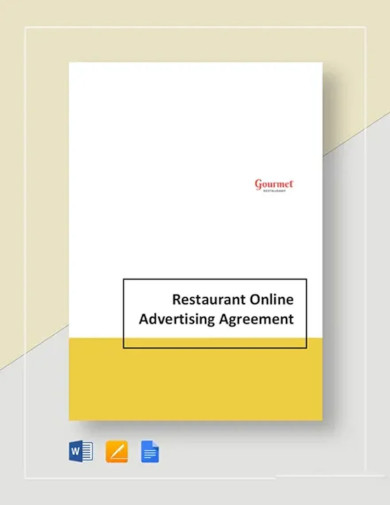
3. Sample Advertising Reseller Agreement Template
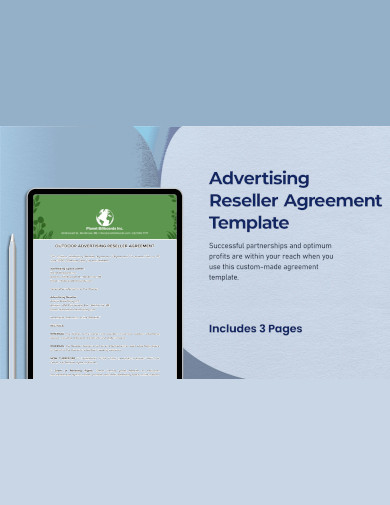
4. Sample Advertising Company Agreement Template
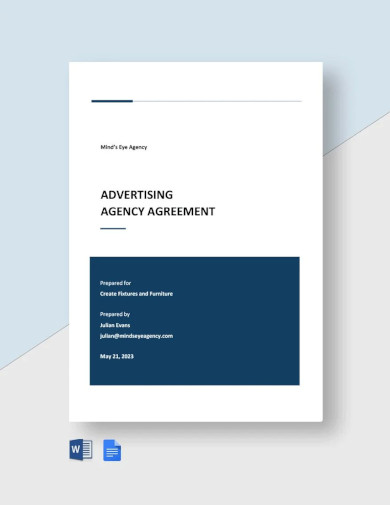
5. Sample Advertising Agency Agreement Template

What is an Advertising Agreement?
An advertising agreement is a legal document that outlines the terms and conditions between two parties, where one party agrees to advertise products or services for the other in exchange for compensation. This agreement serves as a foundation for a business relationship that revolves around the promotion and marketing of goods or services. It is a critical tool for businesses seeking to expand their reach and visibility in the market.
Purpose of an Advertising Agreement
The primary purpose of an advertising agreement is to ensure that both the advertiser and the client understand their rights and obligations. It helps prevent misunderstandings, provides a clear framework for the delivery of services, and outlines the legal recourse for both parties if the terms are not met. This type of sample agreement is essential for any business relationship involving advertising services, as it protects the interests of both parties and sets the stage for a successful advertising campaign.
Understanding the Components of an Advertising Agreement
When entering into an advertising agreement, it is essential to understand its key components to ensure that all parties’ expectations and obligations are clear. Here are the main elements typically included in such an agreement:
Scope of Advertising Services
This section details the specific services the advertiser will provide. It may include the types of advertisements, the platforms they will be used on, and the frequency and duration of the advertising campaign.
Duration of the Agreement
The agreement should specify the start date and the end date of the advertising campaign. It may also include terms for extension or early termination of the agreement.]
Payment Terms
Clear payment terms are crucial. This includes the total cost, payment schedule, and any conditions for additional fees or discounts. It also outlines the consequences of late payments or non-payment.
Intellectual Property Rights
This clause addresses the ownership of the content created for the advertising campaign, including logos, graphics, and other materials. It should clarify whether the advertiser or the client retains ownership of the creative assets.
Performance and Reporting
The agreement should sample outline how the performance of the advertising will be measured and reported. This could involve metrics such as click-through rates, impressions, and conversion rates.
Termination Clauses
These clauses define how either party can terminate the agreement and what happens in the event of a breach of contract. It may include notice periods and any penalties for early termination.
Legal Compliance and Indemnification
The parties must agree to comply with all relevant laws and regulations regarding advertising. The agreement should also include indemnification provisions to protect both parties from legal action resulting from the other party’s actions.
Examples of Advertising Agreements
To illustrate how advertising agreements function in the real world, consider the following scenarios:
Online Advertising A company might enter into an agreement with a digital marketing firm to place ads on various online platforms. The agreement would detail the ad sizes, targeted demographics, and the analysis websites or social media platforms where the ads will appear.
Print Media Advertising A local business may sign an agreement with a newspaper to run a series of print ads. The agreement would specify the size of the ads, the sections of the newspaper they will appear in, and the dates of publication.
Broadcast Advertising A brand could contract with a radio or television station to air commercials. The agreement would outline the length of the commercials, the time slots they will occupy, and the frequency of their broadcast.
Crafting an Effective Advertising Agreement
Creating an effective advertising agreement requires attention to detail and a clear understanding of the advertising sample objectives. Here’s a deeper look into the process and considerations involved in drafting a comprehensive advertising agreement.
Detailed Services and Deliverables An advertising agreement must meticulously outline the services to be provided. This includes the creative development of the advertisements, the selection of media outlets, the scheduling of the advertising slots, and any other related services such as market research or post-campaign analysis.
Targeting and Audience Reach
The agreement should specify the target audience for the advertising campaign. This includes demographic details such as age, gender, location, interests, and any other relevant factors that define the intended recipients of the advertising message.
Content Creation and Approval
The process for creating the content should be outlined, including the stages of development, review, and approval. The agreement should state how many revisions or edits are included and what the process will be if additional changes are required.
Metrics and Success Measurement
Success metrics are vital for evaluating the effectiveness of an advertising campaign. The agreement should define what metrics will be used, how they will be tracked, and the frequency of reporting these metrics to the client.
Confidentiality and Non-Disclosure
Often, advertising campaigns involve sensitive information. The agreement should include confidentiality clauses to ensure that proprietary information, trade secrets, and any other confidential data are not disclosed to unauthorized parties.
Liability Limitations
The agreement should also include limitations of liability to protect the advertising agency from unreasonable risks. This includes scenarios where market conditions or other external factors beyond the control of the advertiser affect the campaign’s success.
Integration with Other Marketing Efforts
If the client has other ongoing marketing initiatives, the advertising agreement may need to include provisions for how the advertising efforts will integrate with these campaigns to ensure a cohesive marketing strategy.
Case Studies: Successful Advertising Agreements
To further understand the importance of a well-structured advertising agreement, let’s explore a couple of case studies:
Case Study 1: Social Media Influencer Partnership A beauty brand partners with a social media influencer to promote its products. The advertising agreement outlines the number of posts, stories, and live sessions the influencer will conduct. It also details the messaging guidelines, the use of specific hashtags, and the requirement for the influencer to disclose the partnership as per FTC guidelines.
Case Study 2: Event Sponsorship and Advertising A tech company sponsors a major industry event and, as part of the agreement, secures advertising space on event materials and digital platforms. The agreement details the placement of logos, the size and type of ads, and the duration of the advertising before, during, and after the event.
Who Helps With Advertising Agreements?
When it comes to drafting, reviewing, and finalizing advertising agreements, several professionals may be involved to ensure that the document is comprehensive, fair, and legally binding. Here are the key players who typically assist with advertising agreements:
Lawyers Specializing in Advertising Law: These legal professionals have expertise in the laws and regulations that govern advertising and marketing. They can draft agreements that comply with all relevant laws, including those related to consumer protection, intellectual property, and digital advertising.
Marketing Agencies: Marketing agencies often have in-house or contracted legal counsel to create standard advertising agreements that can be customized for each client. They ensure that the scope of work, deliverables, and performance metrics are clearly defined.
Contract Specialists: Contract specialists focus on the negotiation and documentation of business contracts. They work alongside lawyers and marketing professionals to ensure that the terms of the agreement are clear and enforceable.
In-House Legal Departments: For larger companies with their own legal departments, in-house counsel will review and negotiate advertising agreements to protect the company’s interests.
Media Buying Agencies: These agencies specialize in purchasing advertising space and time. They often assist in the negotiation of terms and conditions related to media placements within the advertising agreement.
Intellectual Property Attorneys: When an advertising campaign involves significant use of trademarks, copyrights, or patents, intellectual property attorneys are consulted to ensure that the agreement does not infringe on any party’s intellectual property rights.
Compliance Officers: In certain industries, compliance officers may be involved to ensure that advertising agreements and the resulting campaigns comply with industry-specific regulations.
Business Consultants: Consultants with expertise in advertising can provide strategic advice on the structure of the agreement to align with business goals and marketing strategies.
Trade Associations: Organizations such as the American Association of Advertising Agencies (4As) provide guidelines and standard contracts that can serve as a starting point for advertising agreements.
Financial Advisors: They may be involved to advise on the payment terms, compensation structures, and financial implications of the advertising agreement.
6. Sample Contract on Advertising Agreement Template
7. Sample Online Advertising Agreement Template
8. Sample Digital Advertising Agreement Template
9. Sample Newsletter Advertising Agreement Template
10. Sample Advertising Agreement Form Template
11. Sample Magazine Advertising Agreement Template
How do you Create an Advertising Agreement?
Creating an advertising agreement involves several steps to ensure that the document is clear, comprehensive, and legally enforceable. You can also see more templates like Online Advertising Contract Samples. Here is a step-by-step guide to creating an advertising agreement:
1. Identify the Parties Start by clearly identifying the legal names of the parties involved, typically the advertiser and the client, and their respective roles within the agreement.
2. Define the Scope of Work Detail the specific services to be provided. This should include the type of advertising, the creative process, the media channels to be used, campaign duration, and any other responsibilities.
3. Outline the Campaign Details Include the objectives of the campaign, the target audience, the message to be conveyed, and any branding guidelines that need to be followed.
4. Specify Duration and Scheduling State the commencement date, the duration of the campaign, and any key milestones or deadlines. Include scheduling details for when and where ads will be placed.
5. Set Payment Terms Clearly outline the compensation structure, including fees, payment schedules, invoicing procedures, and any terms related to late payments or early termination of the agreement.
6. Address Intellectual Property Rights Determine who will own the creative assets developed during the campaign. Include provisions for the use of each party’s existing intellectual property.
7. Include Confidentiality Clauses Protect sensitive business information by including confidentiality terms, specifying what is considered confidential and the obligations of both parties to protect it.
8. Draft Representations and Warranties Each party should assert that they have the authority to enter into the agreement format and that they will comply with all relevant laws and regulations.
9. Compliance with Laws Ensure that the agreement requires adherence to all applicable advertising standards, consumer protection laws, and any other relevant legal requirements.
10. Detail Termination Conditions Explain how the agreement can be terminated, notice periods, responsibilities upon termination, and any penalties or remedies for breach of sample contract.
11. Include Indemnification and Liability Clauses Protect each party from legal action arising from the other party’s actions. Define the extent of liability and any indemnification provisions.
12. Outline Dispute Resolution Mechanisms Specify how disputes related to the agreement will be resolved, whether through arbitration, mediation, or court proceedings, and include jurisdiction and venue details.
13. Miscellaneous Provisions Add any additional clauses that are relevant to the agreement, such as force majeure, amendment procedures, and assignment restrictions.
14. Review and Negotiate Both parties should review the draft agreement carefully. Legal counsel can help identify any potential issues and negotiate terms that are fair to both parties.
15. Finalize and Execute Once both parties agree to the terms, they should sign the agreement. Ensure that each party receives a copy of the signed document for their records.
16. Monitor and Enforce After the agreement is in place, both parties should monitor the execution of the agreement to ensure compliance with the terms. Keep communication lines open for any necessary adjustments.
By following these steps, you can create an advertising agreement that serves as a solid legal foundation for your advertising campaign, ensuring that all parties’ interests are protected and the campaign can proceed smoothly. You can also see more Website Advertising Agreement Samples.
What is the Indemnity Clause in an Advertising Agreement?
An indemnity clause in an advertising agreement is a provision where one party agrees to protect the other from any losses or damages that may arise from legal claims or disputes related to the advertising services provided. It’s essentially a promise to compensate the other party if certain specified harms occur as a result of the advertising campaign.
Why is Advertising Contract Important?
An advertising contract is important because it clearly defines the terms of the advertising relationship, ensures both parties understand their responsibilities and expectations, and provides legal protection for both the advertiser and the client.
What is the Basic Rule of Advertising?
The basic rule of advertising is to effectively communicate a message about a product or service to the right audience in a way that persuades them to take action, such as making a purchase or learning more about the brand.
In conclusion, an advertising agreement is not just a formality but a strategic tool that ensures all parties are aligned with the campaign’s goals and expectations. It provides a roadmap for the advertising initiative and sets the stage for a successful partnership. By incorporating clear terms and detailed provisions, businesses can leverage advertising agreements to maximize their marketing impact and drive growth.
Related Posts
FREE 10+ Mentoring Agreement Samples In MS Word | Apple Pages | PDF
FREE 10+ Partner Agreement Samples In MS Word | Google Docs | Apple Pages | PDF
FREE 10+ Individual Agreement Samples In MS Word | Google Docs | Apple Pages | PDF
FREE 10+ Strategic Agreement Samples In MS Word | Google Docs | Apple Pages | PDF
FREE 10+ Equity Agreement Samples In MS Word | Google Docs | Apple Pages | PDF
FREE 10+ Producer Agreement Samples in MS Word | Apple Pages | PDF
FREE 10+ Grant Agreement Samples In MS Word | Apple Pages | PDF
FREE 8+ Meeting Agreement Samples in MS Word | Google Docs | Apple Pages | PDF
FREE 10+ Community Agreement Samples In MS Word | Google Docs | PDF
FREE 8+ Real Estate Option Agreement Samples in MS Word | PDF
FREE 10+ Call Option Agreement Samples In MS Word | PDF
FREE 10+ Car Agreement Samples In MS Word | Google Docs | Apple Pages | PDF
FREE 10+ Horse Agreement Samples In MS Word | Apple Pages | PDF
FREE 10+ Option Agreement Samples In MS Word | Google Docs | Apple Pages | PDF
FREE 9+ Project Management Agreement Samples in DOC | PDF
